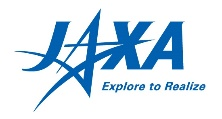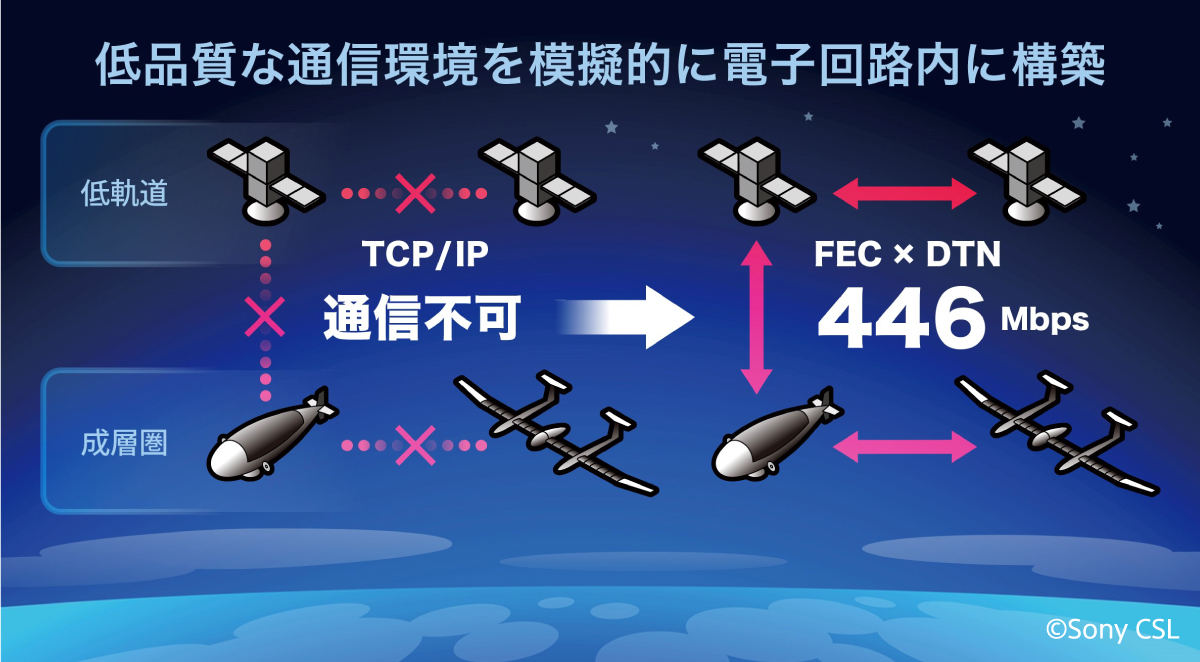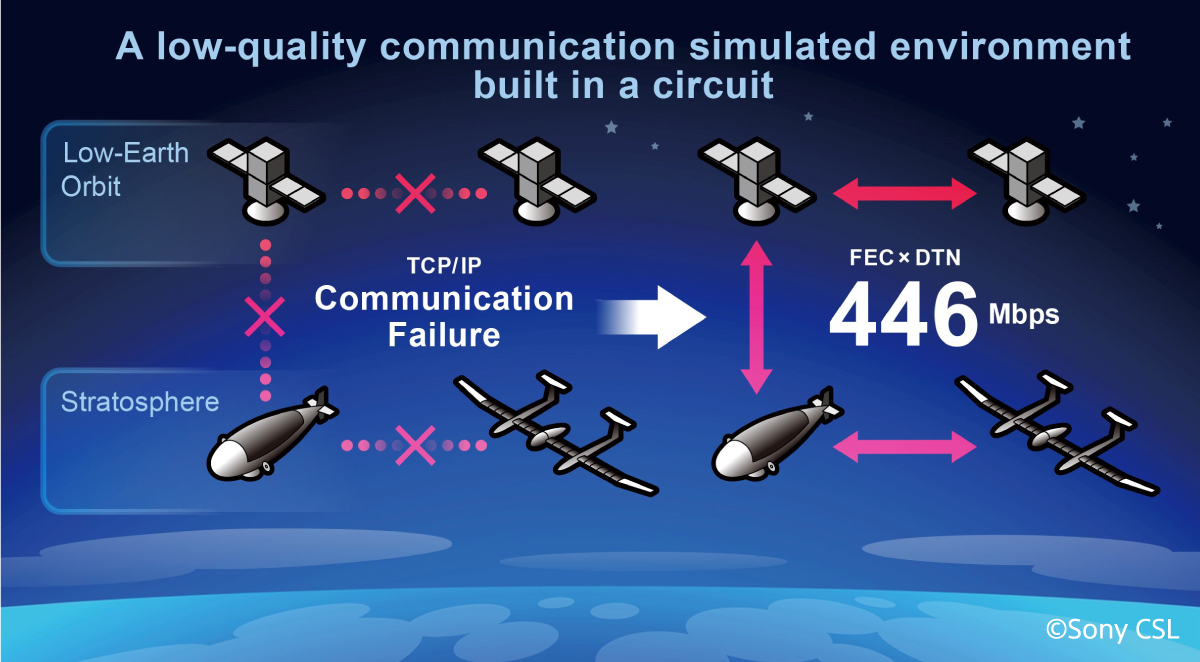 |
 |
成層圏や宇宙でのインターネットサービスの技術基盤となる
エラー発生環境下での完全なデータファイル転送の実証に成功
株式会社ソニーコンピュータサイエンス研究所(代表取締役社長:北野宏明 以下、ソニーCSL)および国立研究開発法人宇宙航空研究開発機構(理事長:山川宏 以下、JAXA)は、「JAXA宇宙イノベーションパートナーシップ(J-SPARC)(※1)」による共創活動のもと、エラーが発生しやすい低品質な通信環境を模擬した地上実験において、将来の成層圏/低軌道での光通信事業に不可欠な、エラー環境下での完全なデータファイル転送技術の実証に成功し、事業化に向けた技術基盤を確立しました。

成層圏や宇宙など、高高度における自由空間光通信の実用化には、通信機器の軽量化・省電力化や通信の高速化が求められる一方で、長距離にある通信機器間で機体の姿勢変動によって送信側機器の出射するレーザー光を受信側機器で安定して受光できないことや、 受信機器内や環境に起因するノイズにより、 デジタル信号の符号誤りが多く生じることのため、安定的な通信品質下での利用を前提としている一般的なインターネット通信プロトコル(イーサネット、TCP/IP)が適用できないという課題があります。
低軌道衛星同士や成層圏無人機との間で利用される光インターネットサービス事業の創出を目指す本共創活動では、ギガビットイーサネット回線上に実験的に構築した自由空間光通信の符号誤り率を模擬した低品質で、一般的なインターネット通信による通信が不可能な通信環境において、446Mbps(※2)の通信速度でデータ欠損なく完全なデータのファイル転送に成功しました。この結果はエラーの頻発する自由空間光通信上でも地上のインターネットサービスのような高速通信が可能になることを示唆したものです。
通信には、ソニーグループがブルーレイ等光デバイスで長年培ってきたレーザー光読み取り技術をベースにソニーCSL が開発した誤り訂正(FEC)技術(※3)と、JAXA が保有する遅延途絶耐性ネットワーク(DTN)技術(※4)とを組み合わせた信号処理技術を用いました。
本通信実証の成功により、地球低軌道や成層圏における2地点間の光インターネットサービスに必要となる高速大容量かつ低消費電力での通信の実現に向けた主要課題の解決が見込まれます。今後、低軌道衛星コンステレーション(※5)や成層圏無人機に搭載された小型光端末同士の通信サービスへの事業展開につながることが期待されます。
ソニーCSL とJAXA は、宇宙における通信ネットワークの研究開発を通じて、引き続き、より高品質な通信サービスの実現に向けて取り組んでいきます。
(※1)J-SPARCは、宇宙ビジネスを目指す民間事業者等とJAXAとの対話から始まり、事業化に向けた双方のコミットメントを得て、共同で事業コンセプト検討や出口志向の技術開発・実証等を行い、新しい事業を創出するプログラムです。
https://aerospacebiz.jaxa.jp/solution/j-sparc/
(※2)コンピュータ間の通信回線に電子回路を挿入することにより低品質な通信環境を人為的に実現。長距離間での微弱な光による高速インターネット通信を想定し、電子回路内で生成したビットエラーレート9.77E-4の疑似ランダムエラー環境において実施した、通信プロトコルとしてTCPを用いたインターネット通信との比較実験による。
(※3)Forward Error Correction の略称。ソニーCSLの自由空間光イーサネット通信用誤り訂正技術は、宇宙データシステムに係る国際標準化を行うCCSDSにて、予備検討規格(Experimental Specification)として提案中です。また、本技術は、2020年3月に低軌道-地上間の双方向光通信に成功した小型光通信実験装置『SOLISS』(Small Optical Link for International Space Station)での通信技術をベースとしています。
https://www.sonycsl.co.jp/press/prs20200423/
(※4)Delay/Disruption Tolerant Networking の略称。DTN 技術は通常のインターネットの通信方式(TCP/IP)の単純適用が困難な通信異常(通信遅延や通信途絶)が生じる通信環境においてもインターネット通信を行うために考案された情報通信技術で、JAXAはISO標準(ISO 21323、ISO 21080)の仕様策定に貢献しています。
https://track.sfo.jaxa.jp/business_overview/busi_over03.html
(※5)多数の低軌道衛星を協調して運用することにより、新しい価値を提供する衛星システム。
株式会社ソニーコンピュータサイエンス研究所コミュニケーションオフィス
Email:csl-pr@csl.sony.co.jp
国立研究開発法人宇宙航空研究開発機構 広報部
 |
 |
File Transfer in Error-Prone Environment, Forming Technical
Foundations for Internet Service in Stratosphere & Outer Space
Sony Computer Science Laboratories, Inc. (Sony CSL, President and CEO: Hiroaki Kitano) and the Japan Aerospace Exploration Agency (JAXA, President: Hiroshi Yamakawa), as part of JAXA’s Space Innovation through Partnership and Co-creation (J-SPARC)*1 program, have successfully conducted an experiment to transfer a complete data file in a simulated low-quality and error-prone communications environment. Accomplishing transfer data in a strict environment is key to future stratospheric and low-Earth orbit optical communications, and Sony CSL and JAXA have established the technical foundations for the commercialization of this technology.

For free-space optical communication to become practical in the extreme altitudes of the stratosphere and beyond, communications equipment must be compact, energy-efficient, and capable of fast transmission speeds. Additionally, the long distances between communications devices mean that any changes to their orientation can result in laser signals from the sending device not being stably received by the receiving device. Signal noise could also occur in the environment and the receiving device causing signal errors. Because of these factors, the standard internet protocol suite (TCP/IP) is unable to secure stable communications link between devices in such environments.
The partnership between Sony CSL and JAXA aims to establish an optical internet service between low orbit satellites and unmanned aircraft for stratospheric telecommunications. An experimental environment with the bit error rate of free-space optical communication built on a Gigabit Ethernet line was simulated in such a manner that communications through general Internet communication was impossible due to low quality. The data file was successfully transferred, complete and uncorrupted, at a speed of 446 Mbps*2 under such conditions. This result indicates the possibility for high-quality and high-speed communications similar to a terrestrial internet service, albeit free-space optical communication.
The communication was done using a signal processing method which combines Sony CSL’s Forward Error Correction (FEC),*3 which is based on the Sony Group laser reading technology that has been refined through the development of optical technologies such as Blu-ray, and JAXA’s Delay/Disruption-Tolerant Networking (DTN).*4
With this successful demonstration, a solution is in sight to the high speed, high bandwidth, and low energy consumption requirements of point-to-point optical internet service in the stratosphere or low-Earth orbit. We expect this to lead to future business development opportunities for communication services, such as small optical communication terminals installed on low-Earth orbit satellite constellations,*5 or unmanned aircraft for stratospheric telecommunications.
Sony CSL and JAXA plan to continue research and development efforts to realize a high-quality communications service in space.
*1 J-SPARC is a program to create new businesses by starting a dialogue between JAXA and private companies that aim for space business, obtaining commitments from both parties for commercialization, and jointly studying business concepts and fostering exit-oriented technological development and demonstration.
https://aerospacebiz.jaxa.jp/solution/j-sparc/
*2 The experimentation compared with TCP was conducted at the pseudo-random error environment. The bit error rate of 9.77E-4 assumes high-speed internet communication between long-distance with a slight light signal.
*3 Sony CSL’s free-space optical Ethernet communication error-correction technology is currently under consideration for experimental specification by the Consultative Committee for Space Data Systems (CCSDS).
In addition, it uses the same base technology as the Small Optical Link for International Space Station (SOLISS) system, which successfully demonstrated two-way communication between low-Earth orbit and a ground station in March 2020.
https://www.sonycsl.co.jp/press/prs20200423/
*4 Delay/Disruption Tolerant Networking is an interoperable networking technology that was devised to carry out internet communications when the TCP/IP does not work due to problems of communication (delay and/or disruption).
JAXA contributed to the specifications of the ISO standards (ISO 21323 and ISO 21080).
https://track.sfo.jaxa.jp/en/business_overview/busi_over04.html
*5 A satellite system that offers new benefits by connecting large numbers of low-Earth orbit satellites.
Sony Computer Science Laboratories, Public Relations Dept. csl-pr@csl.sony.co.jp
JAXA Public Affairs Department : https://global.jaxa.jp/activity/pr/inquiries/index.html